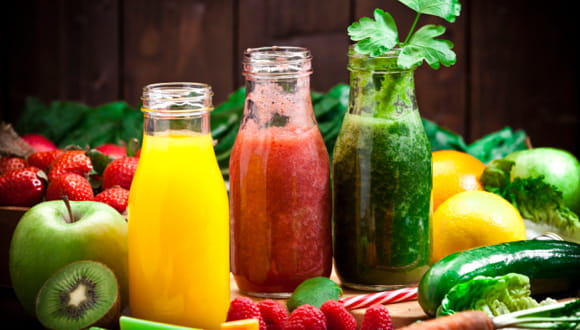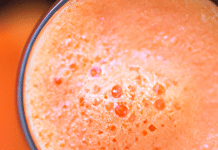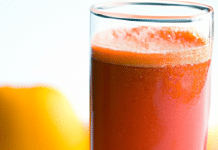Juicing has become a popular trend in recent years, promising a quick and easy way to improve your health. But is it as beneficial as it claims to be?
This article takes a closer look at the potential benefits and drawbacks of juicing, helping you decide whether it’s right for you. So grab a glass of your favorite juice, and find out if juicing is good for you!
Review contents
Potential Benefits of Juicing
Increased Fruit and Vegetable Intake
One of the main advantages of juicing is the potential to increase your fruit and vegetable intake. Many people struggle to consume the recommended daily servings of fruits and vegetables, and juicing can be a convenient way to bridge that gap. By juicing, you can easily consume various fruits and vegetables in one glass of juice, making it easier to reach your nutritional goals.
Enhanced Nutrient Absorption
When you juice fruits and vegetables, it breaks down the cells and releases the nutrients in a more easily digestible form. This can enhance these foods’ absorption of vitamins, minerals, and antioxidants. Juicing can help your body absorb and utilize the beneficial compounds in fruits and vegetables more efficiently, giving you a potential nutrient boost.
Convenience and Variety
Juicing can add convenience and variety to your daily diet. It allows you to experiment with different combinations of fruits and vegetables, keeping your taste buds satisfied. Additionally, juicing can be a time-saver, especially for those with busy schedules. It takes less time to drink a glass of juice than it does to eat a whole fruit or vegetable, making it a practical option for those on the go.
Boosted Hydration
Staying hydrated is crucial for overall health and well-being, and juicing can significantly increase your fluid intake. Fruits and vegetables are naturally hydrating, and juicing them can provide a refreshing way to stay hydrated throughout the day. Adding a glass of fresh juice to your routine can help replenish your body’s water levels and support optimal hydration.
Potential Weight Loss Aid
Juicing has gained popularity as a potential weight loss aid. Many people turn to juice to shed excess pounds, and while it can be a helpful tool, it’s essential to approach it cautiously. Juices can be low in calories and high in nutrients, making them a nutritious addition to a weight loss plan. However, it’s essential to consider the overall balance of your diet and lifestyle when using juicing as a weight loss strategy.
Key Nutrients in Juices
Vitamins and Minerals
Freshly juiced fruits and vegetables are rich in essential vitamins and minerals vital for maintaining good health. Each fruit and vegetable brings its unique nutrient profile to the juice, providing a wide range of essential vitamins and minerals. For example, citrus fruits are high in vitamin C, while leafy greens are packed with vitamin K and iron. By juicing various fruits and vegetables, you can get a diverse array of essential nutrients.
Antioxidants
Antioxidants are compounds found in fruits and vegetables that help protect your body against oxidative stress and free radicals. Juicing is a great way to increase your antioxidant intake, as many fruits and vegetables contain high levels of these beneficial compounds. Antioxidants contribute to overall health and can positively impact your well-being, such as supporting a healthy immune system and promoting youthful-looking skin.
Phytochemicals
Phytochemicals, known as phytonutrients, are plant-based compounds linked to numerous health benefits. These compounds give fruits and vegetables their vibrant colors and distinct flavors. Juicing allows you to access and enjoy various phytochemicals from different fruits and vegetables. Incorporating a variety of colorful produce into your juices can provide you with a diverse array of phytochemicals and their potential health benefits.
Possible Drawbacks of Juicing
Loss of Fiber
One of the main drawbacks of juicing is the loss of dietary fiber. When you juice fruits and vegetables, the insoluble fiber that aids digestion is separated from the juice. Fiber is essential for maintaining digestive health, promoting regular bowel movements, and supporting satiety. To overcome this drawback, you can incorporate fiber into your diet through other sources, such as consuming whole fruits and vegetables or adding fiber supplements.
Caloric Intake and Blood Sugar Spikes
While juicing can be a healthy addition to your diet, it’s essential to be mindful of your caloric intake and its impact on blood sugar levels. The sugar concentration in fruit juices can be higher than eating whole fruits. Suppose you’re watching your calorie intake or have concerns about blood sugar spikes. In that case, practicing portion control and choosing fruits and vegetables with lower sugar content, such as leafy greens and cucumber, is essential.
High Sugar Content
Although fruits and vegetables contain natural sugars, juicing can concentrate their sugar content. This can concern individuals who need to monitor their sugar intake, such as those with diabetes or individuals on a low-sugar diet. It’s crucial to know the sugar content in the fruits and vegetables you’re juicing and consider incorporating low-sugar options into your juice recipes.
Limited Protein and Healthy Fats
While fruits and vegetables are rich in vitamins and minerals, they lack protein and healthy fats. These macronutrients are essential for overall health, and it’s important to have a balanced diet that includes adequate protein and healthy fats intake. If you rely solely on juices as a meal replacement or consume them excessively, you may risk not obtaining enough protein and healthy fats. Consider complementing your juices with other protein and healthy fat sources, such as lean meats, fish, eggs, nuts, and seeds.
The Fiber Factor
Importance of Dietary Fiber
Dietary fiber plays a crucial role in maintaining a healthy digestive system. It adds bulk to the stool and promotes regular bowel movements, preventing constipation. Additionally, fiber helps you feel full and satisfied after meals, aiding in weight management. Fiber also supports the growth of beneficial gut bacteria and helps regulate blood sugar levels. Consuming an adequate amount of dietary fiber daily is essential for optimal health.
Role of Fiber in Juicing
Unfortunately, juicing removes the insoluble fiber found in fruits and vegetables, as it separates the juice from the pulp. While juicing can still provide a wealth of vitamins and minerals, it lacks the beneficial fiber that aids digestion and promotes satiety. If you choose to incorporate juicing into your diet, finding alternative ways to obtain fiber is crucial to ensure your digestive system stays healthy.
Alternative Ways to Obtain Fiber
To compensate for the fiber loss in juicing, you can explore alternative ways to obtain this vital nutrient. One option is to consume whole fruits and vegetables alongside your juices. Chewing on raw fruits and vegetables allows you to retain the beneficial fiber. Additionally, incorporating high-fiber foods such as whole grains, legumes, nuts, and seeds into your diet can help ensure you meet your daily fiber requirements while enjoying the benefits of juicing.
Impact on Blood Sugar Levels
Effect of Juicing on Blood Sugar
Juices, especially those made from fruits, can significantly impact blood sugar levels. When fruits are juiced, the natural sugars are released and can cause a rapid rise in blood sugar levels. This can be especially concerning for individuals with diabetes or anyone trying to manage their blood sugar. Monitoring the types and quantities of fruits used in juicing is essential for keeping blood sugar levels stable.
Choosing Low-Glycemic Options
To mitigate the impact on blood sugar levels, choosing low-glycemic fruits and vegetables when juicing is essential. Low-glycemic fruits, such as berries and cherries, have a minor impact on blood sugar more than high-glycemic fruits like bananas and pineapple. Additionally, incorporating non-starchy vegetables like leafy greens, cucumber, and celery into your juices can help lower the overall glycemic load of the beverage.
Balancing Juices with Fat and Protein
To further manage blood sugar levels when consuming juices, it’s beneficial to balance them with sources of fat and protein. The presence of fat and protein can slow down the absorption of sugar into the bloodstream, preventing sharp spikes in blood sugar. Consider adding sources of healthy fats, such as avocado or nut butter, and protein-rich ingredients, like Greek yogurt or plant-based protein powder, to your juices to help maintain stable blood sugar levels.
Juices and Weight Management
Caloric Value of Juices
Juices can vary significantly in calorie content depending on the ingredients used. Some juices can be relatively low in calories, primarily if they are focused on non-starchy vegetables with minimal fruit additions. However, other juices, particularly those with higher fruit content, can pack a calorie punch. It’s essential to be mindful of the caloric value of your juices and consider their role in your overall daily calorie intake when managing your weight.
Meal Replacement or Supplement
Juices can be used as a meal replacement or a supplement in a weight management plan. As a meal replacement, juice can provide essential nutrients while keeping calorie intake in check. However, it’s essential to ensure that the juice is balanced and provides adequate protein and healthy fats. As a supplement, juices, and balanced meals can add extra nutrients and variety to your diet.
Satiety and Weight Loss
The impact of juices on satiety and weight loss can vary from person to person. Some individuals may find that drinking juice can help reduce cravings and provide a sense of fullness. However, juices lack the bulk and fiber of whole fruits and vegetables, which can affect satiety levels. It’s essential to be attentive to your hunger cues and consider incorporating whole foods and juices to support satiety and a sustainable weight loss journey.
Choosing the Right Ingredients
Quality and Freshness
When juicing, the quality and freshness of the ingredients play a significant role in the taste and nutrient content of the juice. It’s essential to select ripe and fresh fruits and vegetables to maximize the flavors and benefits of the juice. Choose produce free from bruises or blemishes and opt for locally sourced or organic options when possible. High-quality ingredients will enhance the overall juicing experience and provide the best possible nutrients.
Variety of Fruits and Vegetables
Juicing offers the opportunity to experiment with various fruits and vegetables. This allows you to obtain diverse nutrients, flavors, and textures. Including a mix of different fruits and vegetables in your juices will help ensure you’re reaping the benefits of a broad spectrum of vitamins, minerals, and beneficial compounds. Don’t be afraid to try new combinations and explore the vast array of fruits and vegetables available.
Organic vs. Conventional
When selecting ingredients for juicing, you may consider choosing organic produce. Organic fruits and vegetables are grown without synthetic pesticides and fertilizers, which some people prefer to avoid. While organic options can be beneficial, it’s not always necessary. If budget constraints or availability make organic produce challenging, conventional fruits and vegetables can still provide valuable nutrients in your juices.
Potential Allergens
It’s essential to be mindful of potential allergens when juicing. Certain fruits and vegetables, such as citrus fruits, strawberries, and celery, can trigger allergies or sensitivities in some individuals. If you have known allergies or sensitivities, avoiding the specific ingredients that could cause an adverse reaction is crucial. Additionally, be cautious when introducing new ingredients and notice any signs of allergic reactions when incorporating them into your juice recipes.
Potential Risks and Precautions
Foodborne Illnesses
Raw fruits and vegetables used for juicing can be a potential source of foodborne illnesses if not handled and washed properly. It’s crucial to wash all thoroughly produce before juicing to remove potential pathogens. Additionally, store fresh produce properly and consume juices within a recommended timeframe to minimize the risk of contamination. Following proper food safety guidelines will help ensure safe juicing practices.
Interaction with Medications
Some fruits and vegetables used in juicing can interact with certain medications. Grapefruit, for example, can interfere with the metabolism of certain medications, leading to potential side effects or reduced efficacy. If you’re taking medications, it’s essential to consult with your healthcare provider or pharmacist to determine if any potential interactions may occur. They can provide guidance on which fruits and vegetables are safe to include in your juices while considering your medication regimen.
Allergic Reactions
Individuals with known allergies or sensitivities to specific fruits or vegetables should exercise caution when juicing. It’s important to avoid ingredients that could trigger an allergic reaction. If you’re unsure about potential allergens, consult an allergist or healthcare provider who can guide you on safe ingredient choices and help you avoid any potential allergens in your juice recipes.
Juicing and Digestive Health
Impact on Digestion
Juicing can have both positive and negative effects on digestion. On the one hand, removing fiber during juicing can affect the overall digestive process. Fiber helps regulate bowel movements and adds bulk to the stool, promoting healthy digestion. On the other hand, juicing can provide a concentrated dose of nutrients easily absorbed by the body. Introducing fresh juices into your diet can serve as a valuable source of hydration and nutrients supporting overall digestive health.
Digestive Enzymes
Freshly juiced fruits and vegetables contain natural enzymes that aid the digestive process. These enzymes help break down food and support the absorption of nutrients. When you juice, the enzymes present in the produce are released and can enhance digestion. This can be particularly beneficial for individuals with digestive issues or those who may have difficulty digesting certain foods.
Potential Benefits for Certain Conditions
Juicing has been associated with potential benefits for certain digestive conditions. For example, individuals with inflammatory bowel disease or irritable bowel syndrome may find relief by incorporating freshly juiced fruits and vegetables into their diet. Additionally, specific fruits and vegetables like ginger, aloe vera, and mint have been traditionally used to support digestive health. However, it’s essential to consult with a healthcare provider or nutritionist if you have a specific digestive condition to ensure that juicing is appropriate for your needs.
Balanced Approach to Juicing
Moderation and Variety
As with any dietary approach, moderation and variety are essential in juicing. While juicing can offer many potential benefits, it’s essential not to rely solely on juices as a substitute for whole foods. Strive for a balanced approach by incorporating a variety of fruits, vegetables, lean proteins, healthy fats, and whole grains into your diet alongside your juices. This will provide a more comprehensive range of nutrients and support your overall health and well-being.
Combining Juices with Whole Foods
Consider incorporating whole foods alongside your juices to ensure adequate nutrient intake and fiber consumption. While juices can provide concentrated doses of vitamins and minerals, whole fruits and vegetables offer essential dietary fiber and a more complete nutritional profile. Combining juices with whole foods can strike a balance that supports your overall health and ensures a well-rounded diet.
Personalized Approach
Juicing should be approached with a personalized mindset considering your nutritional needs, health goals, and taste preferences. Experiment with different fruits and vegetables to find combinations that you enjoy and provide the nutrients you want. It’s essential to listen to your body and adjust based on how you feel and any feedback from healthcare professionals. Everyone is unique, and finding a juicing approach that works for you is vital to harnessing the potential benefits while avoiding potential drawbacks.
In conclusion, juicing can offer several potential benefits, such as increased fruit and vegetable intake, enhanced nutrient absorption, convenience, and variety. Essential nutrients found in juices include vitamins, minerals, antioxidants, and phytochemicals. However, juicing also has possible drawbacks, including losing fiber, potential blood sugar spikes, high sugar content, and limited protein and healthy fats. It’s essential to consider the fiber factor, manage blood sugar levels, and be mindful of the impact on weight management. Choosing the right ingredients, considering potential risks and precautions, and understanding the impact on digestive health are also crucial. Taking a balanced approach to juicing through moderation, variety, and personalization can help you make the most of this popular dietary trend.





































